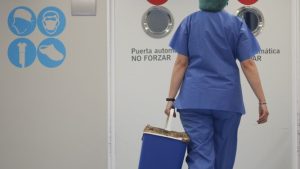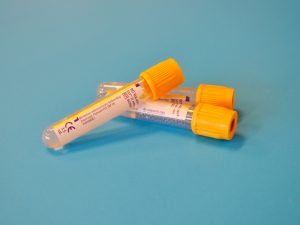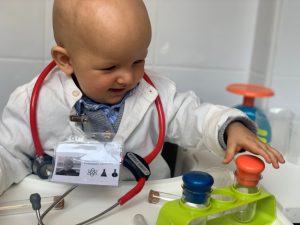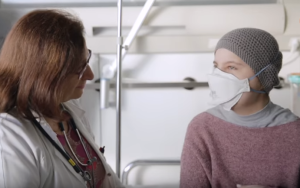Josep Carreras Leukaemia Research Institute
Creation
The Josep Carreras Leukaemia Research Institute, Generalitat de Catalunya CERCA centre, was established in 2010 with the aim of promoting biomedical research and the development of personalised medicine in relation to haematological malignancies and, in particular, leukaemia.
It is an unprecedented centre that, with the work and rigour of researchers from all over the world, uses the most innovative technology in order to win the battle against leukaemia and other haematological malignancies.
Three major forces are right at the heart of the creation of the Josep Carreras Leukaemia Research Institute:

Firstly, the will of Josep Carreras himself, his family and the Foundation that bears his name to perpetuate the fight that began in 1988 with the aim of eradicating leukaemia.

The public administration’s eagerness to consolidate our country as a pioneering area in biotechnology and biomedicine. Since its foundation, the Generalitat de Catalunya has been committed to making a sufficient annual contribution in order to guarantee the centre’s operation.

It was also essential to value the excellent scientific level that already existed in Catalonia, specifically in the field of haematology. The Institute continues the excellent work undertaken by the historic Farreras-Valentí School of Haematology.
The Josep Carreras Leukaemia Research Institute is the first European centre, and one of the few in the world, dedicated exclusively to researching haematological malignancies.
The Institute has five independent coordinated campuses: Campus Hospital Clínic-UB, Campus Sant Pau, Campus Can Ruti, Campus Mar and Campus Trueta. The laboratories at these clinical campuses enable us to work in close partnership with clinicians from the five associated hospitals: Hospital Clínic, Hospital de Sant Pau, Hospital Germans Trias i Pujol, Hospital del Mar and Hospital Josep Trueta.
Why a research institute focused on leukaemia and other haematological malignancies?
Because we can find a definitive cure
Leukaemias, together with other haematological malignancies, are one of the most significant challenges faced in terms of the study and treatment of cancers that affect humans. In fact, they have represented and continue to represent a curable cancer model. This is not surprising given that the two currently curable cancers in a significant number of patients are childhood Acute Lymphoblastic Leukaemia (ALL) and Hodgkin’s Lymphoma.
Although there are many leukaemia subtypes, there are increasingly more methods being developed in order to perfect this classification and, consequently, establish new, less invasive treatments. This is one of the aims of the Josep Carreras Institute, as, colloquially speaking, getting to know the names and surnames of this disease will enable us to make progress in terms of its differential treatment.
Because we can find a definitive cure
One of the factors that becomes important in terms of establishing a research institute specific to haematological malignancies is the incidence of these diseases among the general population. In Spain, the incidence of acute leukaemia is around 6,000 new cases per year.
Because we want to bring research closer to the patient
The evolution of haematology as a medical area in our country is another explanation we can offer to back the need for the creation of the institute.
Haematology is one of the medical specialisms that has seen spectacular development at both a clinical and basic level. If there is an area of medicine able to adapt to and take advantage of the challenges posed by translational research, it is haematology. We need translational research, starting with DNA studies, clinical assistance for patients and clinical trials, and vice versa.
Because we have a good track record
Because we know how to do it
The Josep Carreras Leukaemia Research Institute is the first European centre, and one of the few in the world, dedicated exclusively to researching haematological malignancies.
The dimensions of the centre facilitate the optimisation of efficiency in a way that diverse working groups dedicated to the different lines of research are intricately interrelated.
Why we will never give up
He has dedicated his life to achieving a significant goal: to one day make leukaemia a curable disease for everyone and in all cases, and this Institute was born of the genuine drive to make this happen.
FIND OUT ABOUT THE ORIGINS OF LEUKAEMIA AND OTHER HAEMATOLOGICAL MALIGNANCIES
 Despite all the advances and relentless research, the causes of leukaemia remain unknown and there is still no adequate explanation, as certain people contract the disease and others do not. By way of the study of a significant number of cases, certain risk factors have been identified that could favour the appearance of this disease, such as exposure to a significant level of high energy radiation, certain genetic alterations or exposure to certain chemical agents for long periods of time, among others. However, the exact origin of this disease has never been pinpointed.
Despite all the advances and relentless research, the causes of leukaemia remain unknown and there is still no adequate explanation, as certain people contract the disease and others do not. By way of the study of a significant number of cases, certain risk factors have been identified that could favour the appearance of this disease, such as exposure to a significant level of high energy radiation, certain genetic alterations or exposure to certain chemical agents for long periods of time, among others. However, the exact origin of this disease has never been pinpointed.
FIND A CURE, PREVENT THE DISEASE FROM BECOMING CHRONIC
 In some cases, very effective new treatments that prolong life have been identified, however, they are not a cure. Our goal is to get to the root of the problem: the affected cells. If we understand the disease at a molecular level, we can develop new healing therapies. This is the goal that was achieved at the time by way of haematopoietic progenitor-cell transplantation (bone marrow, peripheral blood and umbilical cord blood), which still remains the only treatment that can provide a cure in many cases.
In some cases, very effective new treatments that prolong life have been identified, however, they are not a cure. Our goal is to get to the root of the problem: the affected cells. If we understand the disease at a molecular level, we can develop new healing therapies. This is the goal that was achieved at the time by way of haematopoietic progenitor-cell transplantation (bone marrow, peripheral blood and umbilical cord blood), which still remains the only treatment that can provide a cure in many cases.
REDUCE THE SIDE EFFECTS OF SOME TREATMENTS

Every day the cure rate of many types of haematological malignancies improves, but patients have to pay a significant price. Many of the treatments undergone are very aggressive (chemotherapy, radiotherapy…). We must find a cure for patients with as few side effects and lasting effects as possible (endocrine disorders, sterility…).
CATEGORISE DISEASES INTO THEIR DIFFERENT SUBTYPES
 In order to make progress in terms of the differential treatment for each disease, we must be aware of their “names and surnames”. This is the only way to establish individualised treatments: therapeutic targets.
In order to make progress in terms of the differential treatment for each disease, we must be aware of their “names and surnames”. This is the only way to establish individualised treatments: therapeutic targets.
FIND OUT TO WHAT EXTENT WE HAVE ERADICATED THE DISEASE
 In order to make more specific decisions regarding patient treatment, we should continue working to better understand the molecular characterisation of each disease. This makes it possible to identify the minimal residual disease following treatment: to find out exactly to what extent we have eradicated the disease and act accordingly.
In order to make more specific decisions regarding patient treatment, we should continue working to better understand the molecular characterisation of each disease. This makes it possible to identify the minimal residual disease following treatment: to find out exactly to what extent we have eradicated the disease and act accordingly.
TO GET THERE IN TIME
 One of the lines of research will be dedicated to predictive studies in relation to the appearance of the malignant blood diseases based on the genetic characterisations of the population. It is always best to be one step ahead of a disease rather than one step behind.
One of the lines of research will be dedicated to predictive studies in relation to the appearance of the malignant blood diseases based on the genetic characterisations of the population. It is always best to be one step ahead of a disease rather than one step behind.
FIND OUT MORE ABOUT COMMON COMPLICATIONS
 The issue not only lies in a better understanding of the development of each disease, but also in the development of control over the most common complications, as many patients end up dying as a result of a complication, often infectious, as opposed to from the illness itself. Other common complications are thrombosis and haemorrhages, which are frequent in patients with haematological malignancies.
The issue not only lies in a better understanding of the development of each disease, but also in the development of control over the most common complications, as many patients end up dying as a result of a complication, often infectious, as opposed to from the illness itself. Other common complications are thrombosis and haemorrhages, which are frequent in patients with haematological malignancies.
FIND OUT ABOUT THE ORIGINS OF LEUKAEMIA AND OTHER HAEMATOLOGICAL MALIGNANCIES
 Despite all the advances and relentless research, the causes of leukaemia remain unknown and there is still no adequate explanation, as certain people contract the disease and others do not. By way of the study of a significant number of cases, certain risk factors have been identified that could favour the appearance of this disease, such as exposure to a significant level of high energy radiation, certain genetic alterations or exposure to certain chemical agents for long periods of time, among others. However, the exact origin of this disease has never been pinpointed.
Despite all the advances and relentless research, the causes of leukaemia remain unknown and there is still no adequate explanation, as certain people contract the disease and others do not. By way of the study of a significant number of cases, certain risk factors have been identified that could favour the appearance of this disease, such as exposure to a significant level of high energy radiation, certain genetic alterations or exposure to certain chemical agents for long periods of time, among others. However, the exact origin of this disease has never been pinpointed.
FIND A CURE, PREVENT THE DISEASE FROM BECOMING CHRONIC
 In some cases, very effective new treatments that prolong life have been identified, however, they are not a cure. Our goal is to get to the root of the problem: the affected cells. If we understand the disease at a molecular level, we can develop new healing therapies. This is the goal that was achieved at the time by way of haematopoietic progenitor-cell transplantation (bone marrow, peripheral blood and umbilical cord blood), which still remains the only treatment that can provide a cure in many cases.
In some cases, very effective new treatments that prolong life have been identified, however, they are not a cure. Our goal is to get to the root of the problem: the affected cells. If we understand the disease at a molecular level, we can develop new healing therapies. This is the goal that was achieved at the time by way of haematopoietic progenitor-cell transplantation (bone marrow, peripheral blood and umbilical cord blood), which still remains the only treatment that can provide a cure in many cases.
REDUCE THE SIDE EFFECTS OF SOME TREATMENTS

Every day the cure rate of many types of haematological malignancies improves, but patients have to pay a significant price. Many of the treatments undergone are very aggressive (chemotherapy, radiotherapy…). We must find a cure for patients with as few side effects and lasting effects as possible (endocrine disorders, sterility…).
CATEGORISE DISEASES INTO THEIR DIFFERENT SUBTYPES
 In order to make progress in terms of the differential treatment for each disease, we must be aware of their “names and surnames”. This is the only way to establish individualised treatments: therapeutic targets.
In order to make progress in terms of the differential treatment for each disease, we must be aware of their “names and surnames”. This is the only way to establish individualised treatments: therapeutic targets.
FIND OUT TO WHAT EXTENT WE HAVE ERADICATED THE DISEASE
 In order to make more specific decisions regarding patient treatment, we should continue working to better understand the molecular characterisation of each disease. This makes it possible to identify the minimal residual disease following treatment: to find out exactly to what extent we have eradicated the disease and act accordingly.
In order to make more specific decisions regarding patient treatment, we should continue working to better understand the molecular characterisation of each disease. This makes it possible to identify the minimal residual disease following treatment: to find out exactly to what extent we have eradicated the disease and act accordingly.
TO GET THERE IN TIME
 One of the lines of research will be dedicated to predictive studies in relation to the appearance of the malignant blood diseases based on the genetic characterisations of the population. It is always best to be one step ahead of a disease rather than one step behind.
One of the lines of research will be dedicated to predictive studies in relation to the appearance of the malignant blood diseases based on the genetic characterisations of the population. It is always best to be one step ahead of a disease rather than one step behind.
FIND OUT MORE ABOUT COMMON COMPLICATIONS
 The issue not only lies in a better understanding of the development of each disease, but also in the development of control over the most common complications, as many patients end up dying as a result of a complication, often infectious, as opposed to from the illness itself. Other common complications are thrombosis and haemorrhages, which are frequent in patients with haematological malignancies.
The issue not only lies in a better understanding of the development of each disease, but also in the development of control over the most common complications, as many patients end up dying as a result of a complication, often infectious, as opposed to from the illness itself. Other common complications are thrombosis and haemorrhages, which are frequent in patients with haematological malignancies.
Become a member of the cure for leukaemia!


